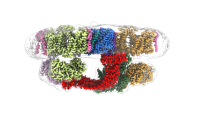Research Labs
-
The Brambrink Lab studies anesthetic-induced developmental neurotoxicity and brain ischemia, using animal models to evaluate the impact of anesthetics on neuroapoptosis and learning behavior.
-
The Clarke Lab focuses on how Ca2+ channels on the plasma membrane couple to the ryanodine receptor and control gating of the receptor.
-
Dr. Danielsson’s research focuses on investigating the role of calcium-activated chloride channels in the treatment of asthma and acute bronchospasm.
-
The D’Armiento Lab's goal is to develop insight into lung physiology and pathology by understanding the mechanisms altering lung injury and repair and translating the findings into clinical solutions.
-
Pediatric surgery patients are vulnerable to iron deficiency and red blood cell transfusion. We aim to define the benefit of iron supplementation and blood conservation strategies to improve outcomes.
-
The Emala lab of lung biology and signal transduction studies airway and vascular biology using cells, ex vivo tissues from animals and humans and in vivo animal models of lung resistance.
-
The Garcia Lab focuses on neurophysiology (including human/rodent EEG and patch-clamp electrophysiology) and behavioral testing in animal models.
-
Dr. Guglielminotti’s research focuses on how to provide equitable access to quality maternal care, improve maternal health outcomes, and reduce disparities in the United States.
-
The Harrison Lab studies ion channels involved in the control of neuronal excitability and virally-encoded ion channels (viroporins).
-
The research of the Hasko Lab is centered on the role of P1 (adenosine) and P2 (ATP) purinergic receptors in regulating inflammation and organ function in sepsis.
-
The research of the HT Lee lab focuses on the pathomechanisms of perioperative acute kidney injury and translational approaches to attenuate this injury.
-
The Hua Lab uses mixed methods to conduct studies that aim to improve the quality of palliative and end-of-life care and critical care through evidence-based implementation strategies.
-
The Ing Lab's research focuses on evaluating short and long-term perioperative outcomes in children using data from established birth cohorts, administrative databases, and electronic health records.
-
The main research interest of the Joshi Lab is the delivery of drugs by the intraarterial route to treat brain diseases.
-
The Lane-Fall Lab applies implementation science, human factors, and systems engineering principles to improve patient safety & communication in perioperative, critical care, and acute care settings.
-
The Levy Lab is interested in evaluating the neurotoxic and neuroprotective effects of low-dose carbon monoxide (CO) in the developing brain.
-
The Epi Lab focuses on population-based studies of injuries, anesthesia safety, and perioperative outcomes with novel epidemiologic designs, and statistical and machine learning techniques.
-
The Mikami Lab investigates neuroimmune mechanisms linking chronic allergic lung inflammation to brain inflammation and altered neurobehavioral outcomes.
-
The focus of the Wagener Lab is on biomarkers, early detection of organ injury, and the effect of vasopressin and other medications on liver blood flow during transplantation.
-
The Yang Lab is interested in understanding how pain, sleep, and the immune system regulate brain development and function.
-
The Yocum Lab is interested in understanding the role that “peripheral” GABAA receptors play in immune and lung physiology.




















